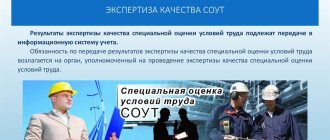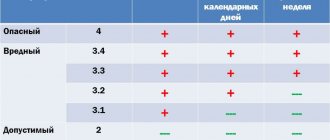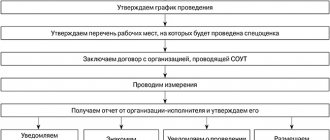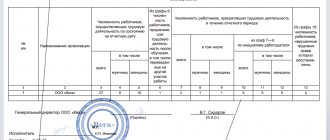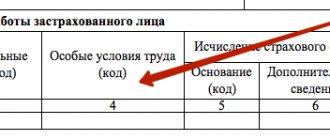What is the purpose of the SOUT card?
The SOUT map includes information:
- due to unfavorable factors;
- classes of working conditions;
- types of guarantees and compensations provided to employees;
- proposals to improve working conditions.
During employment and during the course of work, employees must be informed of the presence of a SOUT card. Read more about special assessment in the articles “What is SOUT” and “Carrying out SOUT”.
During control checks, inspectors from supervisory authorities study the map and the results of the special assessment. They evaluate the condition of the workplace and the firm's compliance with guidelines to improve the quality of working conditions. This data is summarized in the SOUT map. It is filled out based on the results of the analysis of the production sector.
A special assessment card is drawn up for workplaces where measurements of production environment factors were made. For places where no harmful components of production have been detected, a special assessment map is not drawn up.
Which positions are not subject to SOUT?
Let's look at the list of professions and positions that are not subject to SUT. Such a list is established by clause 3 of Art. 3 laws 426 Federal Law:
- homeworkers;
- remote workers;
- employees who began working with an employer who is an individual and is not an individual entrepreneur;
- vacant jobs. A special assessment is carried out after hiring an employee.
Telecommuter
Thus, the answer to the question of which places are subject to SOUT is presented in 426 Federal Laws. According to the law, it is carried out in all workplaces, in all types of companies, regardless of the field of activity, form of ownership, size, etc. There are small exceptions. All employers must organize work according to SAW.
How to fill out the SOUT card
Information is entered into the special assessment card based on the conclusions of the experts of the special assessment commission. The card is filled out according to the prescribed form.
Filling out the header
- We enter the full name of the company, address, full name of the management, email address and other information in the cells.
- We enter the company codes: INN, OKATO, OKPO, OKVED, OKOGU, OKVED. A sample of filling out the SOUT card is given below.
- We fill out the number and enter information about the number of employees and the work performed.
- We enter information about jobs for SOUT in the table. All positions and professions are entered in accordance with the All-Russian Classification of Professions of Workers and Positions of Employees (OK-016-94).
Inaccuracies in filling out this item lead to the fact that the worker does not receive the compensation due to him.
We enter the SNILS number of employees
We indicate the numbers of insurance certificates of employees who work in the company.
Fill in the field about the company’s equipment
We list the available equipment, materials and raw materials. We enter the names: welding machines, lathes, computers, sorting mechanisms.
An example of filling out a special assessment card for working conditions is given below.
How to reflect data on adverse factors
We enter data on unfavorable factors in the workplace into the table. We indicate the class of working conditions.
How to reflect data on guarantees and compensations
If unfavorable working conditions are identified, we provide information on guarantees and compensation payments. We prescribe the grounds for introducing compensation in accordance with legislative norms. We list all guarantees and benefits, referring to the regulatory framework.
Making recommendations to improve the quality of working conditions
At the final point, the cards make proposals to improve the quality of working conditions. In order to reduce the negative effects of unfavorable causes. The commission enters into it instructions that the company is obliged to implement. If no instructions have been issued, write “no”.
Signature by the members of the special assessment commission
The map is approved by commission members and special assessment experts. After this, each employee is familiarized with the document. Employees must sign.
Introducing staff to the results
All workers at the workplace agree with the results of the special assessment for the workplace, not excluding workers who use the workplace for one-time operations.
What happens if the company does not carry out SOUT
According to SOUT expert, researcher at the central laboratory for examining working conditions at the All-Russian Research Institute of Labor of the Ministry of Labor, Natalya Byshova, it is more profitable for an employer to carry out SOUT than to ignore it, since otherwise he will face a number of financial sanctions.
Carefully reading the legislation (from Part 2 of Article 5.27.1 of the Code of Administrative Offenses) we can see that organizations (enterprises, firms, etc.) that ignored the implementation of special assessment and assessment procedures may be subject to penalties in the amount of 50.0 to 80, 0 thousand rub. In addition, already in the current year, 2021, the employer will not have legal grounds to provide employees with compensation for work with harmful working conditions, since they are accrued only based on the results of a special assessment.
Tax deductions due for the payment of workers' compensation will not be available to an employer who has not conducted a SAW on its enterprise.
The employer’s responsibilities also include indicating in the employment contract with the employee or in an annex to it in the form of an additional one, the working conditions of what level of safety correspond to a specific workplace, the basis for which can only be the results of the conducted special labor safety assessment. These violations entail new fines and amount to 80.0 thousand rubles. It won't work anymore. The amount of fines will significantly exceed the specified amount.
And in any case, if it is discovered that there is no SAW, the employer will be required to carry it out and, accordingly, spend money on it.
An example of entering data into a special assessment card for working conditions
When filling out the card, use the instructions in the appendix. No. 4 to Order of the Ministry of Labor dated January 24, 2014 No. 33n.
Documents for SOUT, sample filling:
How to check a report on a special assessment of working conditions
The main objective of conducting a special assessment of working conditions (SOUT) is to establish the final class of working conditions in the workplace by determining the level of exposure to harmful and/or hazardous production factors on employees, which subsequently determines the types of guarantees and compensation provided to them.
The SOUT procedure consists of the preparatory stage, the actual implementation and registration of the results in the form of reporting documentation. The last stage is very important - errors when checking the report can be expensive and even cause litigation. Therefore, before signing the report, it is necessary to familiarize yourself with and understand the assessment results. In addition, the employer has the right to request justification for these results from the organization conducting the special labor assessment.
So, how can you navigate the reporting documentation, whether the organization conducting the special labor assessment provided everything necessary, whether the special assessment was carried out correctly, whether the classes of working conditions were correctly established and whether all guarantees and compensation for harmful conditions were taken into account - in our article we will try to indicate the main points, checking which will help answer the questions posed.
Beware of mistakes
In order to avoid mistakes during the implementation of the special assessment system, even at the stage of identifying potentially harmful and/or dangerous production factors, the organization conducting the assessment should be provided with copies of previous workplace certification materials with the classes of working conditions, guarantees and compensation indicated in them.
The employer should also familiarize itself with the classifier of harmful and/or hazardous production factors. This will help evaluate the correctness of further results based on their identification. Identification of these factors and their sources in the workplace is carried out by examining the place itself and becoming familiar with the job responsibilities of the staff, as well as by interviewing workers and their immediate supervisors. Factors of the production environment and the labor process in the workplace are recognized as identified and subject to assessment if their names coincide with the names provided by the classifier, which was approved by Order of the Ministry of Labor of Russia No. 33n dated January 24, 2014.
Errors can be made by both the organization conducting the SOUT, the employer, and the SOUT commission. For example, sometimes difficulties arise at the initial stage when the commission calculates the number of jobs for positions with the same names and number of employees at each job. The principle is this: the number of jobs must correspond to the number of simultaneously working workers.
It is also important to correctly identify similar jobs. They must comply with the criteria of similarity defined in Art. 9 Federal Law No. 426 “On special assessment of working conditions”. It is enough to conduct a special assessment of only 20% of similar jobs (but not less than two), and the results will be applicable to all jobs. This significantly reduces the costs of SOUT. If some places do not fall under the criteria of similarity, a special assessment is required for 100% of such jobs.
The correct name of the position also plays an important role - it must strictly correspond to the staffing table. It happens that the commission provides a list of positions that does not correspond to reality. Then problems arise when applying the results of the assessment system, assigning guarantees and compensation, and inspections by regulatory authorities.
Important!
When providing an employee with compensation for work in hazardous conditions, it is necessary to take into account not only the Labor Code of the Russian Federation, but also the requirements of other federal laws (if they do not contradict the Labor Code).
In particular, this applies to medical staff. In accordance with the Decree of the Government of the Russian Federation dated February 14, 2003 No. 101 “On the working hours of medical workers,” a reduced working time was established for certain categories of workers in medical institutions: 36, 33, 30 and 24 hours a week.
Health workers involved in diagnosing and treating patients with psychiatric diseases are granted an additional 35 days of leave on the basis of Decree of the Government of the Russian Federation dated June 6, 2013 No. 482. This list goes on. Structure of the SOUT report
According to Article 15 of Federal Law No. 426, the report on the implementation of special assessment and assessment must consist of nine parts, including:
- information about the organization conducting the SOUT, with attached copies of documents confirming its compliance with the requirements of Art. 19 Federal Law No. 426 requirements;
- a list of workplaces where the special safety assessment was carried out, indicating the harmful and/or hazardous production factors identified (established) there;
- cards for special assessment of working conditions with information about the established class (subclass) of working conditions at specific workplaces;
- protocols for conducting research (tests) and measuring identified harmful and/or hazardous production factors;
- protocol for assessing the effectiveness (if carried out) of personal protective equipment used by employees in workplaces with hazardous working conditions. In this case, PPE must be certified in the manner established by the technical regulations. Such an assessment is carried out in order to reduce the class (subclass) of working conditions;
- protocol of the commission containing a decision on the impossibility of conducting research (tests) and measurements on the basis specified in Part 9 of Art. 12 Federal Law No. 426 (if such a decision exists);
- summary statement of SOUT;
- a list of measures to improve the working conditions and safety of workers at whose workplaces the SAW was carried out;
- conclusions of an expert from the organization conducting the SOUT.
Report title page
The title page heading states:
- full name of the employer, location and location of activities;
- TIN in accordance with the certificate of registration of the employer with the tax authority at its location;
- OGRN in accordance with the certificate of state registration of the employer;
- code of the main type of economic activity according to the All-Russian Classifier of Types of Economic Activities (OKVED).
In addition, the title page must contain the full names of the chairman approving the report and the members of the commission for conducting the special assessment, certified by their signatures indicating the date of signing the report. It is very important to check the correctness of the information provided to avoid typos when filling it out.
Before signing the title page, it is necessary to study the results of the SOUT: protocols of instrumental measurements for the presence of all instruments, auxiliary equipment, verification and completion date, measurement methods, indication of measurement locations (the exact address, purpose and room number are required).
Important!
Remember that by signing the report, you agree with its results and approve it. If a representative of the commission for conducting the special assessment does not agree with its results, then he must sign the report marked “dissenting opinion.” This is entered into the minutes of the commission meeting.
Information about the organization conducting the SOUT must contain:
- the full name of the organization, the address of its location and activities, contact telephone number, email address, number and date of its entry into the register of organizations for conducting SOUT, INN, OGRN, number and date of issue of the organization’s accreditation certificate and its validity period;
- Full name and position of the experts who took part in the special assessment work, the date of issue and validity period of the expert certificate for the right to perform these works, the number of the expert certificate and registration number in the register of experts of organizations for carrying out the special work;
- full information about the measuring instruments used by the testing laboratory when carrying out the special assessment and testing (full name, registration number in the state register of measuring instruments, serial number and verification deadline), as well as the date of measurements and the name of the harmful and/or dangerous factor in the working environment and the labor process .
Important!
After reading this document, you can make sure that the SOUT was carried out within the framework of the law: the organization and experts are accredited, and the devices are verified.
SOUT Cards
A detailed description of the map can be found in Appendix No. 4 to Order No. 33n of the Ministry of Labor of Russia. We will focus on the information that needs to be checked for the correctness of the entered data:
— full name of the employer, address of the employer’s location, full name of the manager, email address;
— INN, OKPO, OKOGU, OKVED, OKTMO of the organization where the SOUT is carried out;
— names of positions, professions or specialties of employees in accordance with the organization’s staffing table;
— name of structural units, if any (department, workshop, section);
— the number and numbers of similar workplaces (must correspond to the numbers in the list of workplaces at which a special assessment of working conditions was carried out);
- the number of workers employed in a given workplace (according to the staffing table or actual) for the month preceding filling out the card, as well as the number of workers employed in similar workplaces, including women, persons under 18 years of age and disabled people admitted to performing work at this workplace;
— full name and SNILS of employees;
— a list of equipment, materials and raw materials used at the workplace;
— final classes (subclasses) of working conditions in the workplace according to the corresponding identified harmful and/or dangerous factor of the production environment and the labor process;
— guarantees and compensation provided to the employee on the date of filling out the card;
— the need to provide the employee with appropriate guarantees and compensation based on the results of the special assessment and justification, indicating the relevant regulatory legal act with reference to sections, chapters, articles, paragraphs (if there are workplaces where benefits and compensation were provided before the implementation of the special assessment, it is strongly recommended to check whether the employees retained them based on the results of the special assessment);
— recommendations for improving working conditions, work and rest schedules, personnel selection.
The size of additional tariffs for insurance contributions to the Pension Fund of the Russian Federation (No. 167-FZ “On Compulsory Pension Insurance in the Russian Federation”) also depends on the final class of working conditions. In accordance with the Methodology, the SOUT card (line 021) indicates the SNILS of the workers employed at this workplace. This information is entered to take into account the length of service in harmful (dangerous) working conditions of a particular employee, which is the basis for early retirement provision for such employees.
The card is signed by experts of the organization conducting the SOUT, as well as by the chairman and members of the commission (it is recommended to check their positions and full names).
Consolidated statement
The document is signed by all members of the commission, experts and approved by the chairman of the commission. The summary statement allows you to evaluate the results of the special operational assessment for all workplaces. It contains two tables.
| Table 1 | Table 2 |
|
|
The list of measures
to improve working conditions and safety includes:
- name of the structural unit, workplace;
- name of the measure to improve working conditions;
- purpose of the event;
- deadline for the event;
- structural units involved in the implementation of the event;
- a note on the completion of the event.
The first two points are filled in by the organization conducting the SOUT. The list of activities is signed by all members of the commission, experts and approved by the chairman of the commission.
Expert opinion
The law does not impose special requirements on the form of the conclusion. But in any case, this part of the report is mandatory. is mandatory for the report. It indicates the registration number and date of preparation, which the employer will subsequently refer to when filling out the declaration.
The conclusion contains a summary of the SOUT, namely the number of workplaces in which:
- SOUT was carried out;
- harmful factors have not been identified (therefore, they must be declared);
- optimal and acceptable working conditions;
- harmful and/or dangerous working conditions;
The document can also be supplemented by other expert suggestions, if any.
SOUT was carried out, the report was accepted: what next?
After carrying out the SOUT, the employer must supplement the employment contract with information about the class of working conditions at the employee’s workplace, and list the guarantees and compensation due to him. The employer is obliged to notify the employee in writing of any changes to the employment contract no later than two months in accordance with Art. 74 Labor Code of the Russian Federation. The Ministry of Labor explains in Letter No. 15-1/OOG-2516 dated July 14, 2016 how this clause is included in the employment contract after the SOUT and what to write before it is carried out.
In addition, the employer must familiarize employees with the SOUT card against signature, and also post on the website summary data on the results of the special assessment (information on the establishment of classes of working conditions in the workplace and a list of measures to improve labor conditions and safety in the workplaces where the work was carried out). SOUT). For execution, 30 calendar days are given from the date of approval of the report on the implementation of the SOUT.
In the future, all newly hired employees who will work in workplaces where a special assessment of working conditions was carried out should be familiarized with the results of the special assessment system.
But we must not forget that the employer is obliged to comply with the requirements of the legislation of the Russian Federation on personal data and the legislation of the Russian Federation on state and other secrets protected by law.
comments powered by HyperComments
Share news:
The entry was published on October 24, 2018 by admin in the category Organization of work on labor protection, Special assessment of working conditions.
How to conduct a special assessment of working conditions Blog on labor protection - Unital-M center
2019-02-06 14:57:45
[…] After the completion of the special assessment, the organization that conducted it prepares a report, which must be signed by all members of the commission and approved by the chairman. It is important to pay serious attention to this stage: errors often occur when studying reporting documentation. Before signing the report, you need to thoroughly understand the results of the assessment: are the classes of working conditions established correctly, are all guarantees for harmful conditions taken into account, etc. Read more about how to check the SOUT report in our article. […]
Filling rules
Detailed instructions and recommendations for filling out the document are contained in Appendix No. 3 to the Procedure for Certification of Workplaces for Working Conditions. These recommendations are given for each line of the map.
The responsibility for filling it out rests with a specially created certification commission, which includes:
- Heads of departments or divisions of the company. This category of employees belongs to the management level, so their main responsibility is to check and optimally organize workplaces.
- Lawyers. These specialists are necessary to ensure that the certification procedures and registration of the automated workplace card are carried out as correctly as possible from the point of view of legislation.
- HR workers. They can help in the correct organization of workplaces in terms of their territorial location. They also perform an organizational function: they compile a list of jobs, correct titles of positions and professions, etc.
- Labor and wages specialists, accountants. With their help, you can most accurately calculate possible additional payments and compensation allowances for employees.
- Medical workers. Their goal is to preserve the health of employees and minimize the negative impact that work environment factors have on them.
- Occupational safety specialists. These categories of workers are responsible for drawing up documentation related to their field: labor protection instructions, certification schedules, etc.
- Trade union representatives. They protect the interests of the employee and monitor compliance with labor safety rules and requirements.
- Representatives of the certifying organization. This organization has the form of a legal entity and is invited to participate in the procedure on independent terms. The presence of its representative on the commission is mandatory.
After the certification, all members of the commission put their signatures on the completed certification card form.
A sample workplace certification card form can be downloaded here.
Psychiatric examination before hiring is mandatory in a number of professions. Got sick on vacation? Do you want to apply for sick leave? Read here how to do it correctly. You can find out the competent advice and information you need on calculating maternity benefits in our article.
How to compile a list of jobs for SOUT?
Approval of the list of workplaces subject to SOUT, indicating similar workplaces, is a task of paramount importance for the commission. As practice shows, difficulties arise precisely at this stage. The reason lies in the calculation of the number of jobs by position (with the same titles and several employees).
In accordance with Art. 209 of the Labor Code of the Russian Federation, a workplace means a certain space occupied by an employee, or where he needs to arrive to perform job duties, which is under the direct or indirect control of the employer.
Ways to get acquainted
If the organization has local regulations, then each employee must be familiarized with them upon signature.
This can be done in one of the following ways:
- Sign the document itself. To do this, on the last sheet of the document you need to provide a special table in which the employee, after the familiarization procedure, will enter personal data about himself. Such familiarization marks, as a rule, inspire the greatest confidence among inspection and control authorities, since this does not allow the administration to replace the document or unilaterally make any changes to it.
- Separate employee familiarization sheet. It can either be created for each existing normative act, or it can be maintained as a general one, in which marks will be placed on all documents at once. One of the most important components of this sheet is the column with the date of review. Thanks to it, it will be possible to correlate the fact of familiarity with the document and its revision number. In practice, the employee’s signature must be taken whenever changes are made to the LNA.
- Journal of familiarization with local acts. Its sheets must be numbered and stitched, entries must be made on each line without skipping blank ones. For each fact of familiarization, a separate record (line) must be compiled.
- Include a clause in the employment contract stating that the employee has read all the documents at the time of hiring. This method can be used if the company does not maintain survey logs or questionnaires. When signing an agreement, the employee signs not only in the column indicating receipt of his copy, but also in a special column indicating familiarization with the documents. Judicial practice confirms this method of familiarization as legitimate.
We invite you to familiarize yourself with the salary payment date according to the labor code
Declaration of jobs according to SOUT: who needs to submit and deadlines
Not all employers must submit a document stating that the workplaces in an organization or an individual entrepreneur comply with state regulatory requirements for labor protection, but only those whose workplaces were recognized following the results of the special labor safety assessment:
Until May 1, 2021, such a document had to be submitted only by employers with harmless and safe workplaces. At the end of 2021, this bar was lowered. But one should not assume that the SOUTH is carried out only for such workplaces; on the contrary, it is necessary to check absolutely all workplaces where dangerous or harmful factors can be identified, including offices. Places where such factors are ultimately not identified, as well as workplaces with class 1 or 2 working conditions, are ultimately included in the declaration. In essence, the employer reports that its employees are comfortable working, for which it gets the opportunity to pay insurance premiums at a reduced rate and receives confirmation of the validity of compensation payments to its employees for harmful working conditions. The declaration is valid for five years from the date of approval of the last report on the implementation of the special assessment and assessment process. Now it is clear who submits the declaration for the special assessment of working conditions. Let's figure out exactly how to do this.
Where is the special assessment card stored?
The place or department of the company where documents with the results of the special assessment are stored is determined by the company independently. When a company has a labor protection service or specialist, the data is stored there. If services or an employee are absent, special assessment cards are stored in the personnel department or in the accounting department.
Information about changes:
By Order of the Ministry of Labor of Russia dated September 7, 2015 N 602n, changes were made to the application
GUARANTEE:
See this form in MS-Word editor
Appendix No. 3 to the order of the Ministry of Labor and Social Protection of the Russian Federation dated January 24, 2014 No. 33n (as amended September 7, 2015 November 14, 2021)
Report on a special assessment of working conditions
Title page of the report on the special assessment of working conditions
Registration number of the organization's accreditation certificate
Date of issue of the organization's accreditation certificate
Sample familiarization sheet with local regulations
The current rules establish the obligation of company management at the legislative level to familiarize its employees with the provisions of local documents.
This is primarily due to the fact that local acts of the company regulate the relationships between the parties to labor relations, establish rules and procedures that employees and the administration itself must comply with.
That is, those working in the company must know both their rights and responsibilities. Only after this can you demand something from them. For example, it is possible to bring an employee to disciplinary liability for violating labor discipline if he knew the labor regulations in force in the company. Moreover, the familiarization must be documented.
Attention!
With accepted
local regulations
It is necessary to familiarize both all current employees of the company and newly hired employees.
There are several options for this procedure. However, this is not reflected in any way at the legislative level. Therefore, the company has the right to independently choose how exactly it will bring the provisions of internal standards to the attention of its employees, and how the very fact of reading the standard will be recorded.
